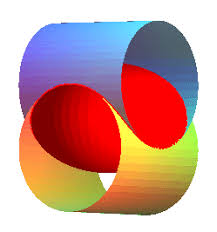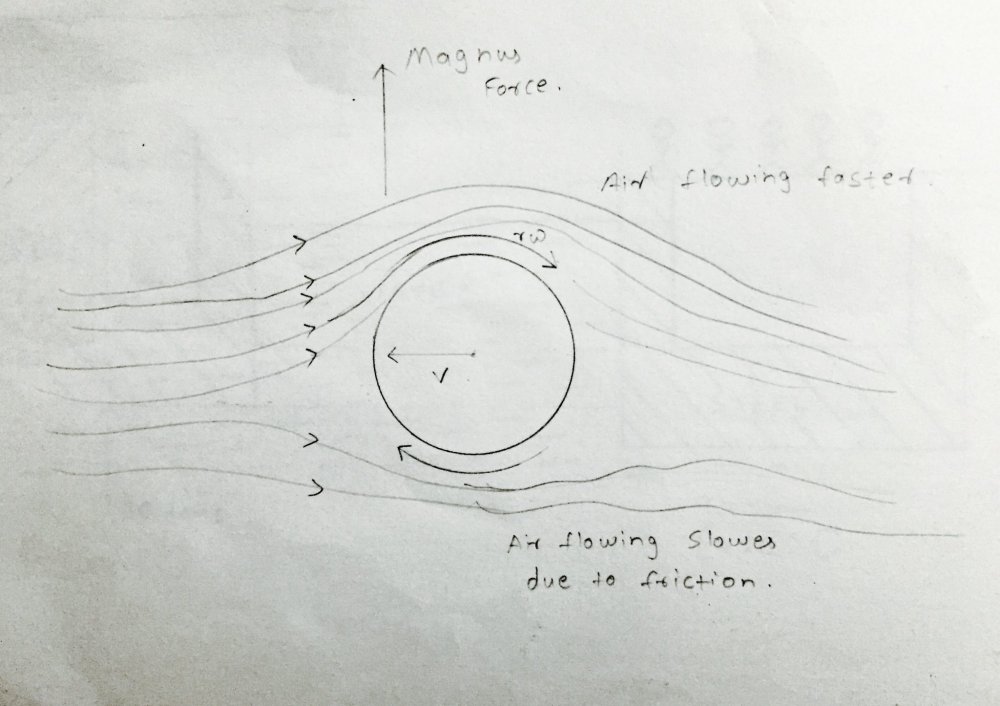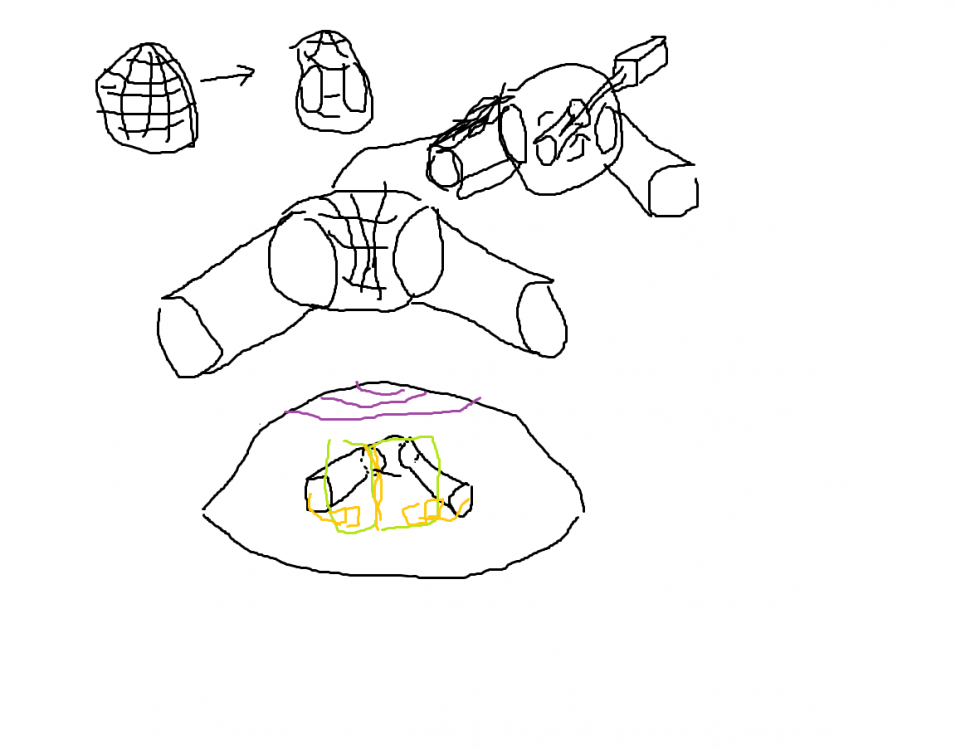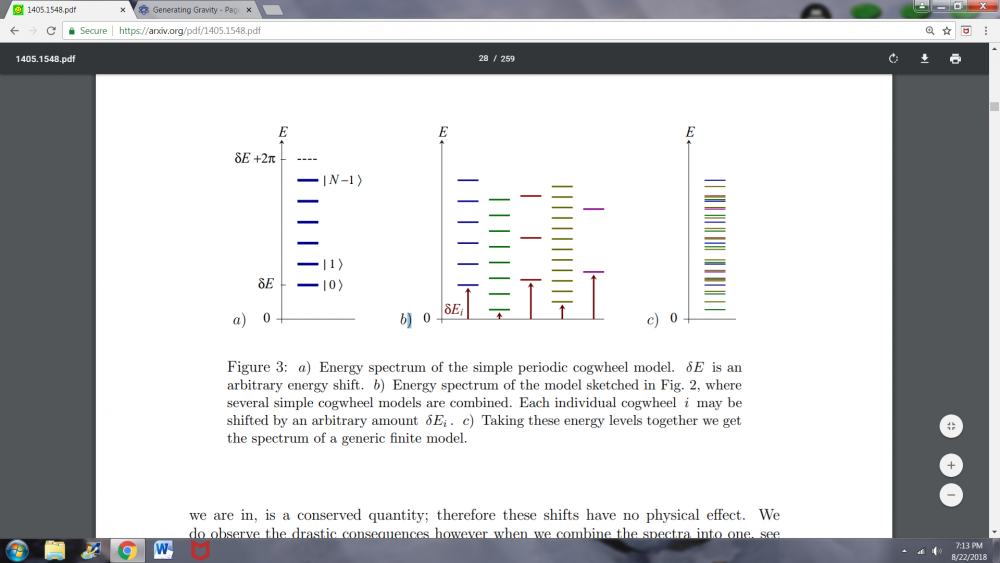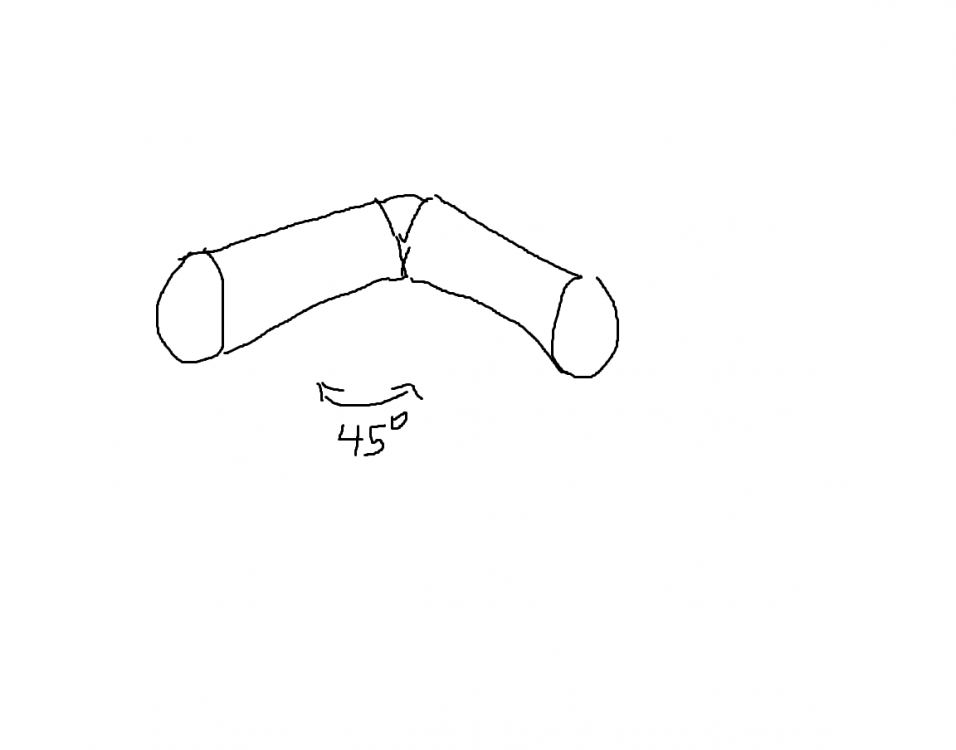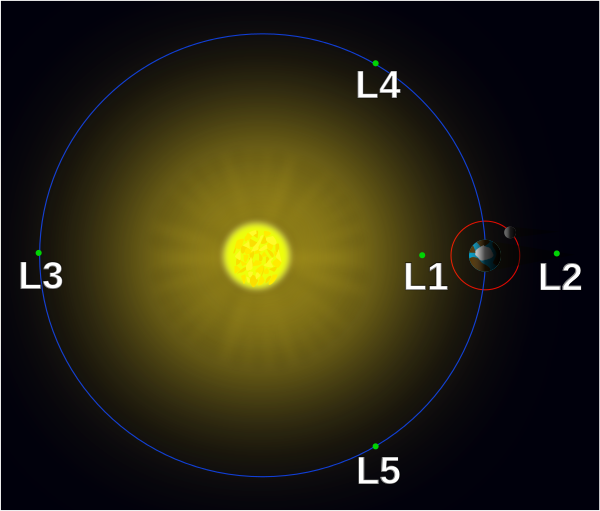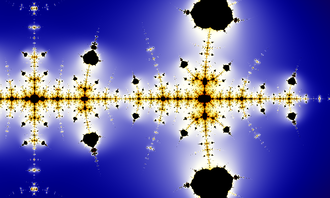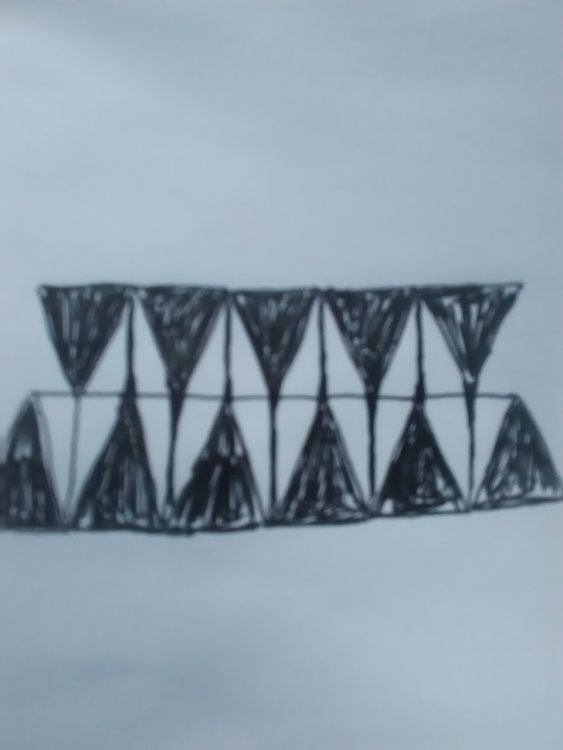-
Posts
77 -
Joined
-
Last visited
Content Type
Profiles
Forums
Events
Everything posted by t686
-
To solve the RedBarron device, there is a tilt in the reflection. Have a bendable rod connected to the spinning cylinder wheel to remove the tilt (the wheel can bend in space freely depending on disturbances). Also, the mountains side-by-side which are how he grooved the wheel, looking at a video a sphere spinning in water, the water sticks to the sphere due to friction. The mountains side by side change that at least removing most of that friction. I could imagine the cylinder gyrating violently initially like a spinning plastic egg before settling into frictionless spinning, and doing that, it might actually attract a solid object like a penny.
-
The two cylinders intersect, but the red part is solid so there is no exchange of air, so each cylinder would suck according to the RedBaron. Also lengthening the end of each cylinder would combat that. If you look up "crab trap" in a particle accelerator, you have 4 magnets around the central collison so the particles collide head on, instead of tilted. Having instead 4 spinners in each tube, in any cylinder, a counterclockwise spinner in the NW and SE, and clockwise spinner in the NE and SW, to "align" things, such a 4 spinning cylinder wheel configuration would possibly align the vortices so things don't "tilt". And I think that it is important that they don't tilt, because I remember in the mirror reflection of the video he showed of the inside of the cylinder, the double circles that are on opposite sides in the reflection and the parallel lines on the perpendicular sides (from the reflection in the cylinder from the "holes in the back" which really weren't holes that led anywhere), that square image was tilted, and having a crab trap would correct that. I believe this would work for my cellular automata. Grouping the 4 spinners like the number five on a dice, leaving the center hole vacant, the 4 spinners are like described above. Then you can group 4 of those large ones into the 4 corners of the number five on a dice, leaving the center vacant. Just keep building. Having 4 long diagonal lines coming out of that square, it shoots 4 "waves" just like in RedBarron's device. The torus wrapping of edges in the 2d automata is like the two cylinders crossing evenly with no shift like above. You can shift two sides relative to each other by say 5 cells in the torus edge wrap, to create the offset pattern of the two cylinders above creating the red sphere. The grouping of the spinners like just described in that fractal grid "aligns" the tilt. The notion that the diagonals of a cell on the screen is longer than the edges of a cell, diagonal movers must move faster across the screen, so in a 2d cellular automata a cylinder is actually has an elliptical cross section and not cylinderical. The only thing left is to consider a few more things, and then I can make the quantum computer on the desktop in a cellular automata. The pattern can be found on conway's life forum in username ntdsc.
-
Just to show a different thing (not the above description), two cylinders that intersect at 90 degrees with the cross section of each cylinder an ellipse, the intersection is a sphere. So Redbarron's device could have two cylinders that intersect, and the cylinder shape is an ellipse (with an ellipse an imploding wave front going towards the center would be more like a graph paper look to the wave or square lattice versus the real space of a circular cross section cylinder). Now since both cylinders are designed to suck air (not a gravity device), the tendency would be to have rotation in TWO SEPARATE CYLINDERS, that are now linked but one spinning ball, ie the physical effect would be like a ball that spins forming a curved path, so if you set up two different and isolated chambers to create the entanglement or another effect with a single chamber and possibly creating entanglement, you could independently control each "spinning cylinder wheel" in each chamber to create a virtual moving ball in space, maybe a jump up and then down, so it would be like energy levels, and it would be a physical quantum entanglement since the cylinders are separated (those two cylinders once the air enters can't travel through that red solid piece, so they're linked across separate regions. By the way, this is the tennis ball curve: https://thatsmaths.com/2014/05/29/the-high-power-hypar/ You could also lengthen the ends of each tube, so that if you create a virtual rotation ball around the red sphere, the two distance points in space at the ends of the long tubes which don't usually interact entanglement-wise would be interacting
-
I was looking at RedBarron's gravity generator, and my idea is to have two metal thin plates close together that have the edges joined as well, so it's a closed suface. Vibrating it sufficiently (with acceleration of the vibration) would suck air towards the flat surface that is empty inside. I figured it out by taking a piece of paper to make a torus, but not the usual way. I'll explain later, but the essential idea is join the 4 corners of the paper, and you end up with two holes and the other hole has to be closed. Now make a sphere out of it (join the top edge of that to the left edge and the right edge to the bottom). With the two holes, you get a flat piece of paper with a sphere inside, or a singularity if you make the leap with the finding of redbarron's sucking in air. I thought I could make a torus with a spinning wheel that is completely closed to pull air towards it, but that doesn't work. So the flat surface above is simply a square box with two sides close together. This has application in my cellular automata in that torus wrapping then sphere wrapping the edges, would make a ball in the automata, but the pattern has to be made right. But this experiment with the metal would be cool. Redbarron's device somehow either makes some type of multiple voids or it actually is a chain motion of moving small strings of air. (and for oscillation since redbarron had a valleyed grooves in his cylinder spinning wheel that drove the suction into the open cylinder, the surface of the metal may need to be cut or grooved somewhere on its surface). Update: If you join the 4 corners of the piece of paper to make two holes in the 3d surface, then make the sphere out of that as outlined above, you have two folds inside that would be welded. So it would be all made of a single sheet of metal with a large hollow another closed surface inside.
-

are there any physicists at all ? which agree with compatibilism
t686 replied to empleat's topic in General Philosophy
Things that appear to be totally nondeterministic (thick fluid on a vibrating speaker will turn into worms, but over time their shape stays the same but they get smaller and smaller (the term fractalised) and automata that have nonstandard rules (like the "fire automata" on softology's blog) are insufficient and just get smaller and smaller over time with no change (they just become fractalised ie the same copy as the original but in a tiny package and much more of the same original shape filling the original boundary), so it appears that something needs to be deterministic but the "appearance" of nondeterminism as a side effect. Norton's dome is an example of using distributions (which have no particular point but things spread out) to prove a certain shaped hill with a ball on top will never roll down or roll down at an unknown time just by following the logic, but with determinism vs. nondeterminism, not sure where norton's dome falls. -
This may not apply to you, but most people I've seen don't walk on their weak leg, more like a skateboard walk with one dominat leg doing ALL the walking and lifting with the other leg just pushing a bit like a skateboard and it's weak , so they're literally moving all on the strong abnormally strong leg (I was walking naked in the woods and I could immediately tell one hip and ass was much bigger, so most people are covered up outdoors and don't find out till much later or never). Try to stand on the weak leg for five minutes with the other leg raised and touch nothing, then jump on it. It's a gradual process of standing on the one leg, jumping, etc. to get blood to gradually go into the weak leg. Also, slow your walking to a sloth pace (slow you strong and "faster moving leg" to the much much slower rate of the weaker leg to catch up, so slow down like you had a recent back operation. This may not help with the plans, but this will help.
-
Also, you say the inside spinning cylinder is ridged or cut so it's ridged. My cellular automata has a spinning oscillator at the center. Your spinning cylinder is an oscillator because it repeats every 360 degrees of a turn. The cellular automata I'm trying to make I believe should be first sphere wrapped (a function in Golly, a cellular automata program that causes opposite edges of the pattern to interact from a large distance). I believe it then should be switched to torus wrap. The torus wrap really isn't a torus (opposite edges interact) although it says it is. It's -roll up the top and bottom- and -roll up the left and right-. So I believe the torus function is actually two different cylinders. My goal is to have the center oscillator balloon up, gyrate, and then throw a smaller oscillator down a stable curved line inside the flicker, by doing sphere then torus wrap. The sphere wrap is unusual. The pattern is a center large square shaped arrangement of pixels with 4 long diagonal lines. I'm thinking about splitting the center large square pattern into 4 equal smaller shapes, which are then split up into the 4 corners of the grid, which is made to be sphere wrapped (I think you can split them up into the top left, bottom left, and top right, with nothing in the bottom right corner if you make it right, due to the weird sphere wrap and how you would rotate the 4 puzzle pieces to make it right), with the 4 diagonals and all consistent (to get it consistent you can -select- the pattern like you're going to copy it, and then use function -flip left to right in golly- to make a clockwise turn into a counterclockwise so everything is consistent. If you make it right it would be a quantum computer. If you try to make it, whatever you do, first select the function -----=make torus= to make the proper boundary, and then switch to sphere for the first play of the pattern. Why? Because the pattern is a mirror, and the clockwise, the top left diagonal is one cell longer than the top right, and you can look at it because the center large square shaped collection of pixels has shifted corners of the square. And you have to select make torus first, because it always selects the entire pattern correctly, otherwise the center oscillator will not spin (believe me I've tried to eyeball it, and the app that is the torus selection gets it right), and then you can switch to the sphere wrap with the same boundary length (it's a square).
-
I would think a simulation would be good for this. The reason you get suction during acceleration of the spinning cylinder, is that since the cylinder is ridged like the earth, if you imagine a "v" shape wave going from the spinning cylinder to the outer cylinder, during acceleration, the spinning cylinder rotates around to the same spot, so you have a train of identical "v"'s going to bounce off the cylinder (actually the leading edge is the original v, and the ones behind it are progressively altered slightly). Also, having two outer cylinders connected to a center spherical chamber, with the two outer cylinders at 90 degrees, with only one spinning cylinder in the sphere, would have a different effect on a smoke cloud outside that apparatus. I have a cellular automata that has 4 runners that are like 4 arrows and the leading edge doesn't change, but as you go further back from the arrow, there is slighter and slighter change, like in your cylinder. You can find that pattern in the first post of "quantum computer" on conway life forum under username ntdsc. Also, check your walking, some of you have a weak leg, so try to stand on that one leg without touching anything for 5 minutes, and then jump on that leg. That's the leg you need to concentrate on. You're gonna have to actually jump on that leg because it's not going to activate otherwise.
-
If you have a single motor that connects to a variable drive (which has variable difference in speed between the two rods that drive the two different tubes), you could have it that whenever there is a "crossing" where the speed of A increases, and A is lower in speed, Speed of B decreases and B is higher in speed or vice versa, the hole to exchange pressure is opened briefly. The pressure difference may be the input to the variable drive, so that when the hole is open to exchange pressure briefly, it's a quantum event or feedback process (similar to neural nets you can have a feedback process that is a quantum process if you make the nerual net right, which they haven't done yet) The only thing I could think it would do: You know each tube sucks air in. This set-up has two tubes connected at 90 degrees, so the openings are separated in space and it's like a half-donut. The only thing I think it could do, is to create a standing type of wave halfway between the openings of the tubes (outside the two tubes, halfway in free space between the two tubes), so you don't get a clockwise rotation of air going around one opening of a tube through the instantaenous opening, out the other opening and back around again, ie the controller of the variable control is connected to a flowmeter that prevents that very thing from happening, so that you always have two separate flows going into both openings of the "gravity" double barrel device. Right there halfway between the openings (not at the instantaneous hole at the groin, ie not there) but outside the two tubes halfway between the two openings would be a very complex standing wave if you design the controller to prevent flow (and the flowmeter would be outside the two tubes at the halfway mark). And you could look at the smoke pattern right there. ie You're looking at flow or air speed, outside the two tubes and halfway between the openings outside the tube, and not measured inside the groin where the instantaneous opening is. So the whole set-up is to have at all times and no matter the probably slight difference in pressure between the two tubes, never a flow going (outside and through the instantaneous hole), but only a pressure flow INSIDE the two tubes. Edit: And there may not need to be any opening in the groin connecting the two tubes, because by spinning one faster, you could generate a greater pressure, and you're only interested in the standing wave pattern outside the two tubes in free space at a halfway point between the openings outside.
-
I thought about it, and if you have two tubes separated by 90 degrees, with one drive in one, the other drive 90 degrees. You could have a variable drive connecting both inside that "groin" between the two tubes. You could have the variable drive controller connected to a single hole that can open and close that separates between the two chambers to allow pressure from one to go to the other. So all you would see in time is -hole open for 20 microseconds, hole closed for 250 microseconds, hole open for 60 microseconds, etc. It would not be a one dimensional cellular automata (because only one on off cell). The picture of the I call it half-dimensional cellular automata would be (c) in the picture below (the spacing in (c) is the spacing of the sequence in time of the "opening of the hole that separates the two tubes", ie the hole would be mostly closed with intermittent (instantaneous opening then immediate closing, so strike the 20, 250, 60 sequence of alternating on,off, you only care about the times of the ---instanatenous opening and then immediate closing---. So you can see it's a sequence in time of a dirac delta function (instantaneous at instantaneous times in the infinite time sequence) of "immediate opening and closing of the hole" at sporadic times and different spacing. I found the picture from Hooft's paper titled "The Cellular Automaton Interpretation of Quantum Mechanics" ie think about the energy levels you'd see, they would be spaced apparantly randomly as in the third picture on opening (and then immediate closing) small hole connecting two tubes at 90 degrees with their own individual drive (but with a variable drive joint connecting them). The variable drive controller might be (ie how you control the variable drive that ultimately controls both or maybe the variable drive design) based on an analysis of what type of waves are entering the two tubes. But the picture in (c) is an energy spectrum from two or more distinct cogwheel models, whereas having the variable drive (which is continuous) would have an infinite addition of distinct cogwheel models, which makes this design perhaps even more powerful than a quantum computer (or perhaps it is a quantum cellular automata but with an infinite sum of the individual cogwheel making up the resultant zeeman atom spectrum seen in (c) but so complicated that it defies analysis of what constitutes the individual member cogwheels that make up the sum). But anyway, it would probably make a much more complicated smoke picture if you do encase it in a dome with smoke. And, based on your design, both tubes would suck in air, so it may create like a bubble or pop, due to the tendency of not allowing any main air flow to go out (only secondary or residual air escapes in your design). The fact that it's bubbling (look at video "shroedinger's smoke" on youtube and the cavitation of a trefoil knot), it would create tori and perhaps individual strings of air that have their own volition, and a very complex intelligent sort of result in that the strings of air could interact.
-
I think it would be good to make two tubes separated by 90 degrees, with a cylinder spinnning in one and another spinning in the other one. I think it would create an interesting scenario right at the 90 degree join of the two tubes, maybe some type of dynamic standing wave. You might have to have one spinning clockwise and the other spinning counterclockwise (not sure yet), but it also might be a feedback system where the pressure at the 90 degree join is fed to a feedback controller that controls the speed of either motor ie the pressure in one tube is a combination of its own pressure, the pressure in the neighbor tube, and the pressure at the join. Edit: the picture should say 90 degrees.
-
I would guess it has something to do with the tube being a cylinder. If you look at the video of the one with the mirrored inside surface, the artefact of having holes in the back only show the topology of the cylinder and has nothing to do with the holes. Perpendicular to the cylinder, parallel lines perpendicular to the cylinder, in the reflection will cross over each other forming repeating circles side-by-side on two sides of the inside cylinder. That makes me believe that tubes of air (perpendicular to the back wall of repeated circles, and the cylinder's mirror surface shows how they cross in the mirrored reflection or fold over each other on only two sides, with the other two sides remaining parallel lines in the reflection (looking at the reflection of the back line or holes or whatever they are, it has something to do with the topology of a wrapped cylinder) emanating from those fictional repeated circles could pull in air through some effect although I don't know the effect yet.
-
It's interesting that the angle in the L1, L4, and L5 lagrange points is the same or very similar to the angle in the Collatz Fractal
-
Actually, it's if the surface were smooth, which makes me wonder if you understand English. The metal rotating cylinder is smooth already. I'm telling you to put blobs of solder on your object: Rotating Cylinder to create the same effect as you have with the vibration presently. I apologize if that's how my statement came out.
-
I didn't say oscillating the speed. I referred to the vibration (up-and-down) of the metal apparatus on a metal table. You can see it vibrating and I wasn't referring to varying the speed. But thank you for telling me that the sides may have something to do with it, maybe so (the hidden part). I doubt it, because the shape of the regularly spaced tabs that are welded and curved to shape like a fan (when the apparatus is vibrating like hell, again not referring to speed but vibration like that football game that vibrates and causes the players to move randomly). The bird crap tabs shaped like tabs when the apparatus is vibrating is an up-down repeating and regular oscillation from the vibration and those tabs convert to circles side-by-side when vibrated (just look at the f****** video and you can see the conversion to circles in the back from regularly spaced tabs to circles just look at the f****** video). Putting circular raised solder blobs on your rotating metallic cylinder in the back on the metal rotating cylinder, would "bump" the air up-and-down as well as those "bump" impact air along the rotating cylinder surface with now bumps on it. But you also need the curved metal repeating bird drop weld in the back which you already have. The vibration causes them to close over a neighbor forming a train of continuous circles side-by-side whereas without vibration they were only regularly spaced curved lines with distinct spacing (having circles, which have nothing to do with the blobs of solder in the shape of tiny half spheres placed on the cylinder surface, now causes repeating tubes of air parallel to each other in a circle along the cylinder and the tubes of air exit which is what is drawing the air in just like a fan along those tubed, like you said you found something new). Putting the apparatus on a nonvibrating surface and doing what I told you to do, which is putting circular or half sphere blobs in some pattern on the cylinder wheel does the same thing the vibration does so you don't need to vibrate it any more. Sorry if I burst your bubble. By the way, this reminds me of the Enigma machine or similar machines that were cryptographic and makes me wonder if the raised circular blobs (which you don't have but I'm saying put on the cylinder surface so you don't have to vibrate it) on the rotating cylinder might have some other application.
- 188 replies
-
-1
-
In any event, the regular spacing of the welding splatter is there and causes it, congratulations. To make it better I thought it would be good to solder raised metal dots on the cylinder wheel that spins. It's the up-down motion of the vibration that causes the regular spacing of welding splatter to cross itself forming a train of repeating circles around the inside that cause the tubes of air emanating from the 2d circles (repeating) in the back. It's like a tattoo gun that regularly moves a needle back and forth, the vibration does the same thing (in "crossing" the welding splatter lines, just re-watch the video to see the change to a train of circles in the back). Now dropping little daps of solder or little dabs of round welding splatter all over the cylinder's surface, would cause as the cylinder's surface rubs against the air, to cause the up-down motion without the vibration, and it should cause a more dramatic suction of air into the pipe than vibration, since the air would be moving up-down all the way around the cylinder (the oscillation) as opposed to only up-down oscillation of the vibrating entire apparatus. But you have to still have the bird crap welding splatter that you have right now in the regular spaced curved lines, but placing dots on the cylinder (ie combine the two ideas in this sentence) creates oscillation without needing your apparatus to vibrate at all, and it should have a stronger directing force inside.
-
I noticed the regularly spaced curved metallic "raised segments" that line the inner back wall at the very back inside the black plastic tube. Like you say, the vibration does something and changes the dynamics (perhaps creating cavitation versus just having the spaced segments generate a fan from the spinning cylinder, you change the dynamic to cavitation or perhaps an oscillator as vibration would be up and down repeating motion), you can see in the reflection, those "raised segments" in the reflection turn into a train of circles side by side versus just regularly spaced "raised segments". Probably those trains of side-by-side circles actually set up -tubes- side-by-side that survive as tubes of air that reach all the way to the opening and perhaps the train of side-by-side tubes of air that are now vortexed create like an irrigation water lifter that tracks air inside the solid black plastic tube that houses the spinner.
-
It probably has to do with the square cells of graph paper. If you measure the diagonal of a square 2d cell on the graph paper, it's longer than the edges. Therefore if the cells start to blink on and off according to some rule, but they all update at the same speed, if you look at -apparant- diagonal motion across the graph paper, those apparant moving objects you see in the blinking lights (if you see anything moving diagonally that is a distinct shape), must travel faster than up-down or left-right movers in the random flicker, because THEY HAVE TO TRAVEL A GREATER DISTANCE. That could lead to imbalances if a few of those cells are placed and rules are being cycled like in a cellular automata, diagonals being faster probably causes dark strings in the random flicker to curl back and form a figure eight whenever two holes equally spaced collapse inward, (for the black string to form the figure out around) and you have a clockwise or counterclockwise spinning oscillator in the middle of the two holes. The oscillator, or repeating sequence of on and off cells would cause those strings to be able to EXIST IN THE FIRST PLACE. So it's to generate strings, and specifically donuts or tori, that cavitate a closed dark string, but the pattern, with edges wrapped is somehow in the shape of a trefoil knot so upon cavitation, it turns into a donut, and then you have a quantum computer on a cellular automata running on the desktop. If that is how the universe formed, I don't know. Edit: I don't think the diagonal moving faster causes the figure eight to form around the two holes, but it's that imbalance versus up-down and left-right speed that is natural on the graph paper that IMAGES the presence of the figure eight within the flicker, as having two holes and an oscillator in and of itself would make such a thing form, but it's the breaking up of the square cells in the mind due to the speed imbalance that allows you to see that. It's probably just a guidebook on how to make the pattern right. It seems like a horrific timing problem (maybe to place "tiles" of repeating objects that have one diagonal longer of the tile than another), but the advantage is that this automata is in an expanding explosive rule, so things don't have to be engineered like most automatas.
-

Moving stack of weyl semimetal sheets
t686 replied to t686's topic in Modern and Theoretical Physics
-
I have an idea to move a bank of weyl sheets relative to each other to create tunneling strings through the weyl cones either through superconducting levitation or moving vertical sheets past a surface with magnets under an overall driven field. Moving the sheets towards then away from each other at constant velocity can time a controllable string to flow instantaneously through those selected weyl cones by selecting the change in movement of those selected sheets. I thought about it and it's possible to shift the magnetic field up and down just across one sheet, and connect through wires to another sheet that has an independent up and down field too to link the two sheets or more. This has an analogy to branes, in that entanglement through strings is the same as qubits. And you could do the same thing with created photonic weyl circuits as they can't create pure enough weyl semimetal crystals yet as the atoms have to be laid perfectly or they're glitches.
-
Wouldn't a spherically contained bose-einstein condensate, rotated about the z, or up and down axis form tori, first by forming vertical vortices, and due to centripetal acceleration cause the up and down vortices to oscillate. Where several neighboring vortices cross around a central up and down vortex, in a small section of the up and down, their intersection would form a torus, with smaller vortex threading through it. As well, couldn't they form on a bias around a central, so the tori can as well propagate along curves deviating away from the up and down direction. You can consider a cross section of a vortex to be the 2d cross section of a 3d horn torus, although these would form 3d tori.
-
What if the vortex laser tunnelled through a condensate and created long vortices to the center. The condensate may have vortices in them if the tunnels that the laser create by spinning about the axis of the central vortex in the laser. If many beams are directed at a spherical collection of condensate and the condensate were magnetic with containment, the space between beams might bulge along the length of parallel vortices, due to repulsive effects of a magnetic condensate. Then the bulge would form tori in the vortices, and an array of tori may form. They create vortices in the lab by stirring the condensate in circular paths with a regular laser. The vortex laser, however, spins along the axis of the central beam.
-
I figured out how to make a computer exactly the same as a black hole. On the surface of a hollow sphere will be point sources of magnetic force. Inside the sphere is a dye that phosphoresces in light similar to the recent experiment that condensed light at room temperature inside that dye. The dye here will be magnetic in charge, and it's a gaseous atom. The force will be directed inwards except at several points to create something similar to the hyperbolic octahedron, with pointy tubes where the magnetic force wasn't directed. Then with the other points originally still on, apply force towards those pointy tubes. They will descend towards the contained sphere, but will form a vortex as it does, due to the atoms needing to stay away from each other magnetically. All the tips will be driven inward, inside that sphere, and the wortex will continue and begin to cause spiralling tubes surrounding it in the sphere. This will probably need to be experimented as the tubes need to be as thin as possible and as great a number as possible. But at those descending tips spiral in they may cause the incident tubes that begin to spiral to flow back towards the containment at which point those points would be shut off while the descending tubes, those magnetic point forces stay on. At which point as the ones coming out reach full length, push them back in. This may end up with greater and greater numbers of tube spirals coming out and thinner. And you keep pushing them back in, until at some point I imagine it will collapse to an array of tori, as a torus is the most minimal magnetically contained surface. That's what I wanted to achieve, because black holes have an array of stringy tori, and a vortexed laser flows through them, lighting the tori it flows through and keeping the ones it doesn't dark. A light/dark automata or punch card of a binary computer shows up randomly in a planar arrangement. The tori are condensates, and 2d cross sections of the horn torus as representation of a cross section of the vortexed laser flows through the tori. But since the tori plus laser light is a condensate when the laser string flows through, multiple copies of that 2d cross section is formed, instead of just one, because the condensate is a quantum object. If a random nondeterministic algorithm is executed (could be a quantum circuit), it takes at the theoretical limit ever possible path at every branch of a nondeterministic algorithm, but it would be close to the theoretical limit here, because photon condensates are a stronger violator of bell's inequalities than qubits are. The donuts plus laser light evolve to several string glowing through the holes of a 3d (small) collection of tori, and looking at the length not the tip as the string enters to the right in 3d of one next to it and flows down next to the other, a wavelike front is propagated along the length not the tip, as viewed like that in a 3d fashion. Several assemblies of the 3d wave circulation will form clouds, as just above magnification of 3d collections of wavelike entitites is a vapor cloud. Those clouds could contain neuron like circuits which would eventually develop intelligence, but who knows how long. To speed things up, either place the computer in a robot with a regular computer and neural nets, and every once in awhile feed those nets into the computer, and see if that improves things, as this may be a way to accelerate its learning process. Clouds in real thunderstorms have a large 2d cross section of the horn torus at the base that sucks up air in a vortexed (large coherent string) string of moist air which gets converged on at higher levels by smaller streams of vortexed air (the cross section of which is a 2d horn torus). This definitely creates a condensate, and so multiple copies of those small as well as larger 2d cross sections of the laser (in a horn torus cross section) are propagating out in a way tha tyou can consider tiny actors spreading out over a map as they walk finding the shortest path over several different points that he has to walk through. If he can split into many copies he would find the answer quickly. So if this can b e built, it would accelerate artificial intelligence.
-
I solved the travelling salesman problem. This needs to be programmed, and the other actions will need to be programmed probably as well. Consider a planar sheet of holes one below the other. Call it 200 holes in the x, and in the y, form a plane down to the center. Near the surface of the outer sphere, fire lasers in the holes surrounding the x direction, so you form a containment of lasers all the way down to the center of the sphere, containing your automata. In the xy plane will be a grid of squares just like in a cellular automata. Say you have 14 cities, and you want to find the minimum distance starting at city 1, going to an arbitrary city 2, down to city 13, and back to city 1, and you form black squares at the position coordinates from a map, and paste those coordinates on a piece of graph paper representing the cities. To solve the problem, you draw on your graph paper one possible path ie draw lines connecting the cities in an arbitrary possible total path, starting at city 1, to another city, and so on back to city 1 (the path will probably not be minimal). So you fire at the start the containment laser, shortly behind that fire a lasers at the same time down the y direction with spacing in the laser so you have dark squares where the connections and single square representing the actual city coordinates on a map . If you consider this as water, the "hollow dark tubes" representing the arbitrary path between all cities, a tube between two cities, at one city, the vortex tube will disconnect and connect to another city. The tubes will settle into the lowest energy or minimum path going through all cities and back to the first as water. The same thing will happen for the laser. (I said fire the lasers down the tube with spacing down the plane into the y direction, but it may be that that initial pulse is fired across the area between two outer shells, which then form the vortexed laser with spacing down through the holes in the y direction, the holes being drilled regularly spaced holes in a computer with hollow shell inside hollow shells, the holes drill into the surface of the shells.
-
The computer will be designed as a sphere. Just beneath the surface inside the sphere will be a smaller sphere with short distance to the sphere, a smaller shell within a shell. In the smaller shell are simply holes, not tubes, but holes drilled so that it you connected lines between holes, the 2d pattern is the same as a fence. There are no connections or tubes between shells, but only over the surface of a shell are regularly spaced drilled holes in the shell in a 2d fence or diamond spacing. At a small distance away from this second shell (a sphere) is a third smaller sphere with holes drilled in the same pattern as the second shell and so on with hollow spheres (or shells) all the way down to near the center of the outer shell in the middle where there's empty space. This is best explained with water. If you pumped in water in between all the shells and start a flow, mini tornadoes form in the space between shells where a hole above between two shells forms a tornado to the hole below in that space between two shells. The tornadoes will not completely fill all spaces between two holes in a space between two shells but some tornadoes will stop and will appear as if tornadoes are dancing around or flashing on and off and will look like a cellular automata. I looked at a thunder cloud forming yesterday, at the base of which was the apple shape or 2d cross section of the horn torus, where the cloud is sucking up moist air the same way water flows down a string hanging from a branch. At higher levels in the cloud were smaller torus cross sections and then smaller and smaller ones. They should continue that way until the size of the vaporous condensation. The same thing will happen in this spherical circuit of a laser pumped in with dye to condense the light in the small spaces between any two shells that descend one shell beneath another all the way and stop some distance from the center where a sphere call ball of light will collect. Many tornadoes in a large area will flow to smaller and smaller collections until the vaporous level just like in a real thunder cloud. Those clouds of light are the same as the ones formed in a black hole and the center of potential intelligence, but will form randomly, as the circuit randomly forms its own structures, automata, and circuits. The sphere could be shrunk if the outer shell and descending smaller shells are folded like a coral.


